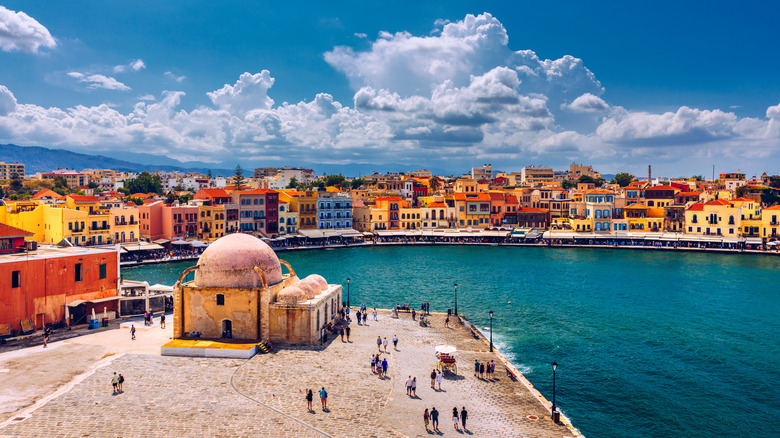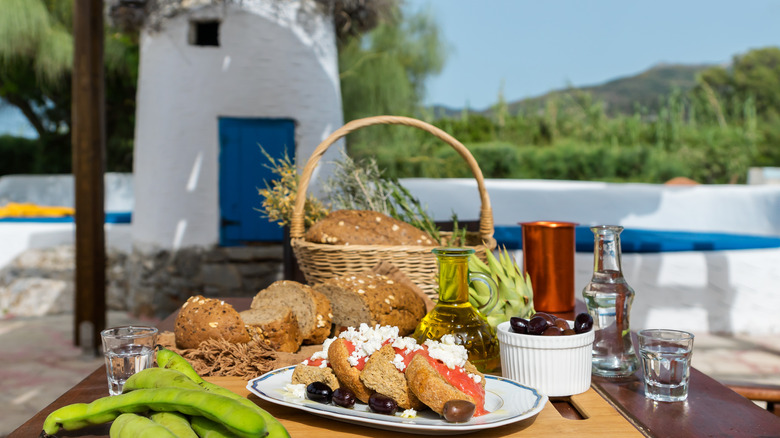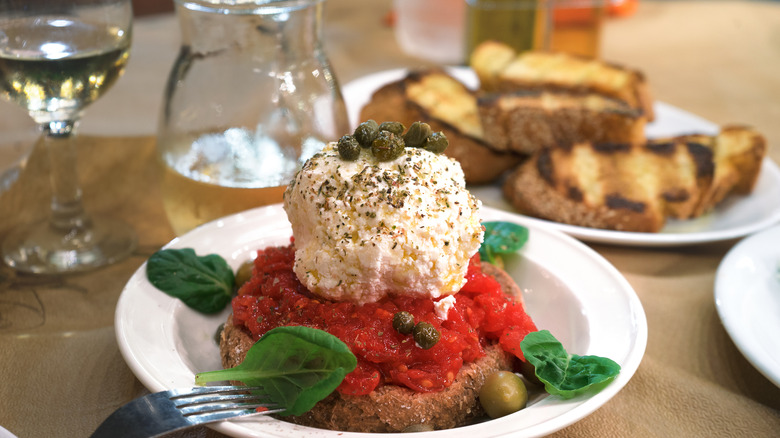The Cuisine Of Crete Hasn't Changed Much In 4,000 Years
In modern society, people have more access to foods and ingredients than ever before. Almost any ingredient can be obtained via the internet or (in the case of the most elusive foods) a trip to its mother country ... if you can get it back through customs, of course. But if we go back in time, before the age of the information superhighway and express shipping, we remember that our ancestors lived off the land. They raised their livestock, grew their own vegetables, and perhaps got their hands on something from out of state from travelers passing through. Indeed, cuisine in many parts of the world has come a long way with the help of technology.
Still, there are places on the globe where time seems to have stood still, and this isn't necessarily a bad thing. These are the places people seek out to experience pristine nature, zero cell phone interruptions, and truly local cuisine. The island of Crete is one of these places (besides the cell service thing). Crete is a Greek island that sits in the middle of the Mediterranean Sea, south of Greece and Turkey, and north of the African countries of Libya and Egypt. Completely surrounded by water, Crete is a place where beautiful fruits, grains, vegetables, herbs, and greens have thrived for thousands of years. Naturally, its earliest citizens would have based their diet off what was available on the land, but apparently, the island produces goods so extraordinary, modern Cretans see no reason to change that.
A brief history of Cretan cuisine
According to historians, humans began settling on Crete around 6500 BCE, and by about 3000 BCE the Minoan civilization surfaced. These early Cretans had access to products like honey, olives, and greens that were grown and produced in abundance in the fields and mountains of the island. Over the course of multiple millennia, Crete saw various cultural and culinary influences from a large pool of civilizations, such as mainland Greece, Arab countries, the Venetians, and the Ottomans. Despite the influx of various customs, the Cretan diet remained steadfast in utilizing its own goods when they were in season.
Crete may be one of the best examples of the popular Mediterranean diet esteemed by doctors and dieticians alike. The island is a natural producer of many of the mainstays of the diet like olive oil, whole grains, fruits and vegetables, nuts, legumes, and seafood. However, even though Crete sits in the center of the Mediterranean, seafood is not a regular part of the local's diet, unless they live on the coast. Instead, meat that is raised on their land, like goat and lamb, is enjoyed regularly. Freshly made, local cheese is also an important part of Cretan cuisine, which typically comes from goat or sheep's milk. The flavors and styles of cheeses tend to vary between villages. Of course, wine is also an important part of the local diet, which comes from ancient vineyards.
Food that withstands time
Today in Crete, you will find dishes that feature the same ingredients the islanders have been utilizing for 4,000 years. The food is prepared simply but beautifully, which really lets the treasures of the island shine. Olive oil is used in everything from cooking to baking sweets, and cheese is enjoyed on its own or used in pastries.
Grains grown on Crete are made into bread such as Paximadi, which is made of 90% barley and 10% wheat; it is baked before being dried in the sun. In ancient times, this was done to prevent spoilage, but today, the dried bread is used to make things like Dakos, where the bread is soaked in olive oil and topped with local cheese and tomatoes.
Wild greens are still enjoyed on the island as they would have been centuries ago. Stamnagathi is sauteed, dressed in lemon juice, and used to accompany lamb while askordoulakous is often pickled or used to make salads. Another Cretan favorite that's stood the test of time is snails. Move over France, because Cretans have been enjoying them for thousands of years. They are known as chochlioi bourbouristi and, today, are dusted in flour, fried in olive oil, and flavored with vinegar, wine, and herbs.
These are just a few examples of modern Cretan cuisine that haven't changed much over time. While change is good, we're glad the food on this island has remained stuck in the past.


